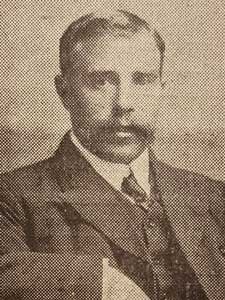Mr Philip Francis Vigott 1 was born in St Mary's, Jersey in the Channel Islands on 6 October 1879 and baptised ten days later.

Philip Vigott's baptismal record
He was the son of Philippe François Vigott (b. 5 August 1853), a farmer, and his wife Eliza Jane Buesnel (b. 2 October 1856), both Francophone Jersey-natives who were married in Grouville on 11 October 1873. Five days prior to that Philippe's elder brother John Louis was married to Eliza's elder sister Mary Ann.
Philip had seven siblings: Eliza Jane2 (b. 11 October 1873), Laura Philippa (b. 7 October 1878), Sidney Philip (b. 2 March 1881), Mabel Elise (b. 22 January 1882), Bertie Wilford Philip (b. 13 March 1887), Cyril Clifford Philip3 (b. 14 October 1888) and Susie Delecia (b. 7 December 1889). He also had two half-sisters from his father's second marriage, Gladys Eliza Julia4 (b. 18 March 1893) and Ruby May5 (b. 15 May 1894).
Philip appears on the 1881 census living at Auckland House, St Lawrence, Jersey and his father was described as a farmer of 18 acres. They would be listed as living at Pissol Farm, St Brelade, Jersey by the time of the 1891 census.
Philip's mother later passed away and his father was remarried on 8 September 1892 to Amelia Julia Buesnel (b. 27 April 1862 in Grouville), his late mother's sister.
At the time of the 1901 census Philip and his family were living at Grey Road, Gorey, Jersey and he was described as a baker's assistant. When he went to sea is unclear and he would later be absent from the 1911 census. Between both census records his father had passed away, succumbing on 25 December 1904.
When he signed on to the Titanic on 6 April 1912 Vigott gave his address as 2 Windsor Terrace, Southampton. His previous ship had been the Kinfauns Castle and as an able seaman he could expect monthly wages of £5.
Vigott was rescued in lifeboat 13 but was not called to provide evidence to either the American or British Inquiries into the disaster.

Philip Vigott from a 1921 identity card
(National Archives, courtesy of Michael Poirier)
A handsome man, Vigott never married and continued to serve at sea during WWI and into the 1920s and beyond. He was a member of the Manchester Unity of Oddfellows, a friendly society. Among the ships he served aboard were the Norman, Walmer Castle, Stirling Castle and Winchester Castle. He later left the sea and worked as a rigger and by 1939 was living at 68 Manor Farm Road, Southampton.
Philip Vigott died at 70 Manor Farm Road in Southampton on 2 July 1941, leaving an estate valued at £770. He is buried in South Stoneham Cemetery, Southampton (section G9, plot185) in an unmarked grave.

Comment and discuss
-
I've been working on the profile picture of Vigott's biography. I think it is the only known photograph of him in times of the disaster (The Jersey Morning News of 21

Open Thread Leave a Reply